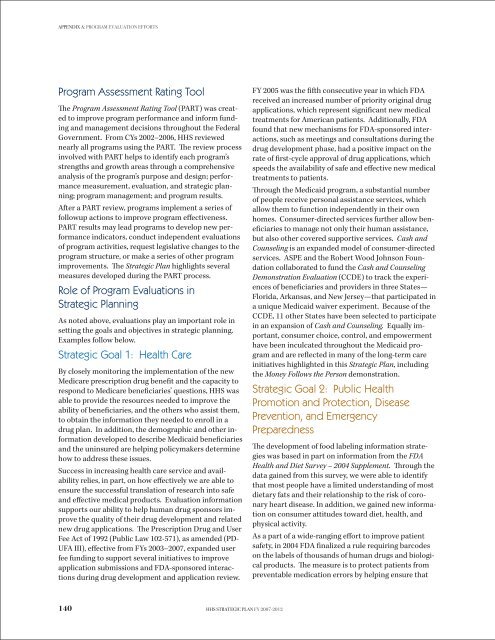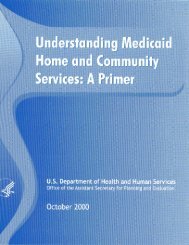STRATEGIC PLAN - ASPE - U.S. Department of Health and Human ...
STRATEGIC PLAN - ASPE - U.S. Department of Health and Human ...
STRATEGIC PLAN - ASPE - U.S. Department of Health and Human ...
Create successful ePaper yourself
Turn your PDF publications into a flip-book with our unique Google optimized e-Paper software.
Appendix a: program evaluation effortsProgram Assessment Rating ToolThe Program Assessment Rating Tool (PART) was createdto improve program performance <strong>and</strong> inform funding<strong>and</strong> management decisions throughout the FederalGovernment. From CYs 2002–2006, HHS reviewednearly all programs using the PART. The review processinvolved with PART helps to identify each program’sstrengths <strong>and</strong> growth areas through a comprehensiveanalysis <strong>of</strong> the program’s purpose <strong>and</strong> design; performancemeasurement, evaluation, <strong>and</strong> strategic planning;program management; <strong>and</strong> program results.After a PART review, programs implement a series <strong>of</strong>followup actions to improve program effectiveness.PART results may lead programs to develop new performanceindicators, conduct independent evaluations<strong>of</strong> program activities, request legislative changes to theprogram structure, or make a series <strong>of</strong> other programimprovements. The Strategic Plan highlights severalmeasures developed during the PART process.Role <strong>of</strong> Program Evaluations inStrategic PlanningAs noted above, evaluations play an important role insetting the goals <strong>and</strong> objectives in strategic planning.Examples follow below.Strategic Goal 1: <strong>Health</strong> CareBy closely monitoring the implementation <strong>of</strong> the newMedicare prescription drug benefit <strong>and</strong> the capacity torespond to Medicare beneficiaries’ questions, HHS wasable to provide the resources needed to improve theability <strong>of</strong> beneficiaries, <strong>and</strong> the others who assist them,to obtain the information they needed to enroll in adrug plan. In addition, the demographic <strong>and</strong> other informationdeveloped to describe Medicaid beneficiaries<strong>and</strong> the uninsured are helping policymakers determinehow to address these issues.Success in increasing health care service <strong>and</strong> availabilityrelies, in part, on how effectively we are able toensure the successful translation <strong>of</strong> research into safe<strong>and</strong> effective medical products. Evaluation informationsupports our ability to help human drug sponsors improvethe quality <strong>of</strong> their drug development <strong>and</strong> relatednew drug applications. The Prescription Drug <strong>and</strong> UserFee Act <strong>of</strong> 1992 (Public Law 102-571), as amended (PD-UFA III), effective from FYs 2003–2007, exp<strong>and</strong>ed userfee funding to support several initiatives to improveapplication submissions <strong>and</strong> FDA-sponsored interactionsduring drug development <strong>and</strong> application review.FY 2005 was the fifth consecutive year in which FDAreceived an increased number <strong>of</strong> priority original drugapplications, which represent significant new medicaltreatments for American patients. Additionally, FDAfound that new mechanisms for FDA-sponsored interactions,such as meetings <strong>and</strong> consultations during thedrug development phase, had a positive impact on therate <strong>of</strong> first-cycle approval <strong>of</strong> drug applications, whichspeeds the availability <strong>of</strong> safe <strong>and</strong> effective new medicaltreatments to patients.Through the Medicaid program, a substantial number<strong>of</strong> people receive personal assistance services, whichallow them to function independently in their ownhomes. Consumer-directed services further allow beneficiariesto manage not only their human assistance,but also other covered supportive services. Cash <strong>and</strong>Counseling is an exp<strong>and</strong>ed model <strong>of</strong> consumer-directedservices. <strong>ASPE</strong> <strong>and</strong> the Robert Wood Johnson Foundationcollaborated to fund the Cash <strong>and</strong> CounselingDemonstration Evaluation (CCDE) to track the experiences<strong>of</strong> beneficiaries <strong>and</strong> providers in three States—Florida, Arkansas, <strong>and</strong> New Jersey—that participated ina unique Medicaid waiver experiment. Because <strong>of</strong> theCCDE, 11 other States have been selected to participatein an expansion <strong>of</strong> Cash <strong>and</strong> Counseling. Equally important,consumer choice, control, <strong>and</strong> empowermenthave been inculcated throughout the Medicaid program<strong>and</strong> are reflected in many <strong>of</strong> the long-term careinitiatives highlighted in this Strategic Plan, includingthe Money Follows the Person demonstration.Strategic Goal 2: Public <strong>Health</strong>Promotion <strong>and</strong> Protection, DiseasePrevention, <strong>and</strong> EmergencyPreparednessThe development <strong>of</strong> food labeling information strategieswas based in part on information from the FDA<strong>Health</strong> <strong>and</strong> Diet Survey – 2004 Supplement. Through thedata gained from this survey, we were able to identifythat most people have a limited underst<strong>and</strong>ing <strong>of</strong> mostdietary fats <strong>and</strong> their relationship to the risk <strong>of</strong> coronaryheart disease. In addition, we gained new informationon consumer attitudes toward diet, health, <strong>and</strong>physical activity.As a part <strong>of</strong> a wide-ranging effort to improve patientsafety, in 2004 FDA finalized a rule requiring barcodeson the labels <strong>of</strong> thous<strong>and</strong>s <strong>of</strong> human drugs <strong>and</strong> biologicalproducts. The measure is to protect patients frompreventable medication errors by helping ensure that140 HHS Strategic Plan FY 2007-2012
















